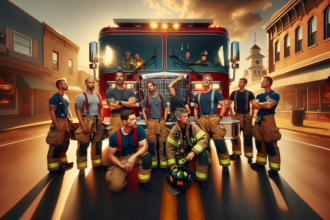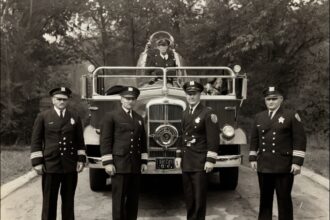Fireman Mustache
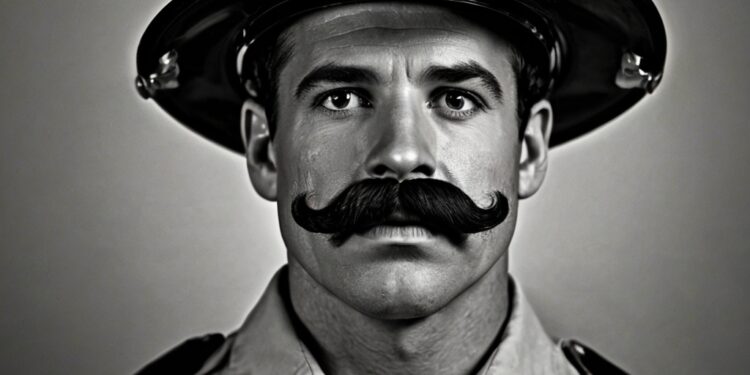
Firefighter mustaches served a greater purpose beyond style and appearance. These facial features acted as primitive smoke filters during rescue operations at the time when modern breathing equipment didn’t exist. Firefighters would moisten their mustaches to help them breathe in hazardous conditions inside burning buildings.
This practical necessity transformed into a powerful brotherhood symbol within fire departments over the last several years. New York City Fire Department’s members demonstrate this tradition, with approximately 40% sporting mustaches today. Safety concerns with oxygen masks have led the department to prohibit full beards. The tradition of firefighter mustaches endures as a symbol of unity, experience, and service to the public, though advanced breathing apparatus has replaced their original smoke-filtering purpose.
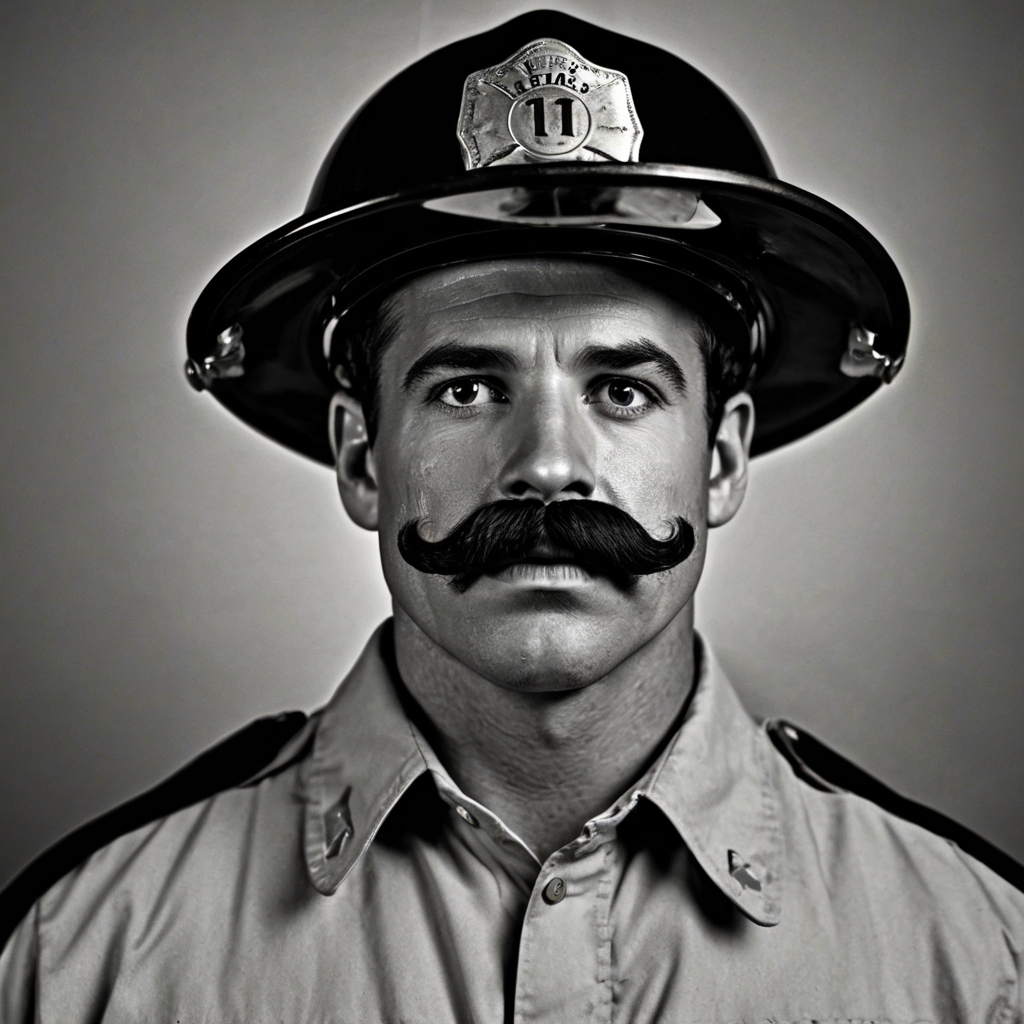
Table of Contents
- 1 Early Origins of the Firefighter Mustache
- 2 Safety Rules and Facial Hair
- 3 Why Firefighters Keep the Tradition
- 4 Modern Day Firefighter Mustaches
- 5 Impact on Firefighting Culture
- 6 Some FAQs about the fireman mustache:
- 6.1 What is a fireman’s mustache?
- 6.2 What is the police mustache called?
- 6.3 What is the military mustache called?
- 6.4 What percent of firefighters have mustaches?
- 6.5 What is Spanish mustache?
- 6.6 What is a gunslinger mustache?
- 6.7 What mustache is most attractive?
- 6.8 Why doesn’t the army allow beards?
- 6.9 What is a biker mustache called?
- 6.10 What does a mustache symbolize?
Early Origins of the Firefighter Mustache
Firefighters in the 18th and 19th centuries used an unusual but practical way to protect themselves – their beards. Fire departments made it mandatory for firefighters to grow full beards. These brave fire warriors would drench their facial hair in water and bite down on it. This created a basic but somewhat useful filtering system.
Smoke filtration in early firefighting
The idea behind this practice was simple. Firefighters would wet their mustaches before they entered buildings filled with smoke. Their wet facial hair worked like a basic filter that let them stay longer in burning buildings than firefighters without beards. Victorian-era firefighters would sweep their thick facial hair across their mouths to protect themselves from deadly smoke.
Traditional firefighting equipment
Firefighting equipment’s development brought major improvements in breathing protection. John Roberts created the first proper “smoke filter” in 1825. It had a leather hood and a hose attached to the leg. His design recognized that air near the floor was easier to breathe during a fire.
Early firefighting equipment saw these key developments:
- LaCour’s Device (1863): The first known self-contained breathing apparatus used an airtight India rubber bag that gave 10-30 minutes of clean air
- Nealy Smoke Mask (1877): One of the first filter-type protective devices came with mica or glass eyepieces
- Merriman’s Smoke Mask (1892): America’s first airline respirator used water pressure to create an air vacuum
Brooklyn New York Fire Department used the Loeb Patented Smoke Respirator around 1875. It had an advanced filter made of charcoal and wool soaked in glycerin. These breakthroughs replaced facial hair as a filtering tool, though many firefighters kept their mustaches as part of tradition.
“Beard filters” might have caught larger ash particles, but they proved inadequate as fires became more toxic. This pushed the continuous development of better breathing apparatus, which led to today’s advanced respiratory protection systems.
Safety Rules and Facial Hair
Safety regulations have revolutionized how fire departments handle their facial hair policies. The Occupational Safety and Health Administration (OSHA) enforces strict guidelines about facial hair that interferes with respiratory protection equipment.
Modern breathing apparatus requirements
Self-contained breathing apparatus (SCBA) needs a perfect seal between the mask and the firefighter’s face. OSHA regulations specifically ban facial hair between the sealing surface of the facepiece and the face. Even a small amount of facial hair growth can substantially reduce the protection level of positive-pressure systems.
The science behind these regulations leaves no room for doubt. A proper seal prevents:
- Smoke and toxic gases from entering the mask
- Compromised air supply leading to dizziness
- Exposure to harmful chemicals and particulate matter
Department regulations on mustaches
Fire departments of all types have detailed grooming standards that balance safety with tradition. Most departments allow well-managed mustaches that don’t interfere with SCBA equipment. Standard regulations state that mustaches must not extend more than half an inch below the corner of the mouth or one inch past the corner.
Sideburns have similar restrictions and must be neatly trimmed without extending beyond half an inch below the ear. These exact measurements help maintain both safety and professional appearance.
Firefighters with religious or cultural reasons to keep facial hair face tough decisions. NIOSH currently works on a project to evaluate respirator effectiveness for workers with facial hair. This research could lead to innovative solutions that accommodate these needs.
These rules apply equally to career, combination, and volunteer fire departments. Fire department leaders who allow facial hair that interferes with SCBA seals violate NJPEOSH laws and NFPA national standards. Incident commanders must also ensure that mutual aid firefighters follow these safety standards during emergency operations.
These strict regulations serve a vital purpose – they protect firefighters in hazardous environments. Annual quantitative fit-testing ensures each firefighter’s SCBA works properly. Those who fail to meet these requirements may work on tasks outside hazardous environments until they comply with department standards.
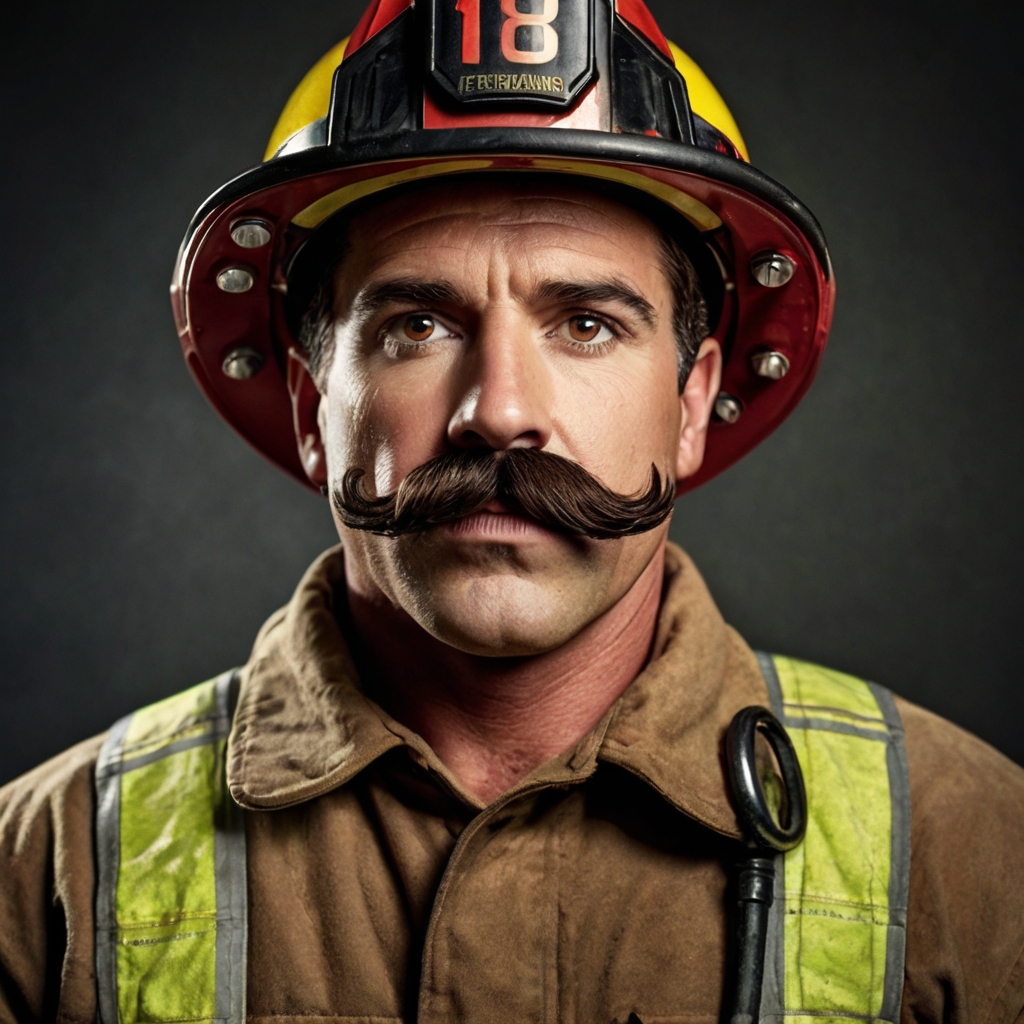
Why Firefighters Keep the Tradition
Mustaches stand as cherished emblems of firefighting culture in firehouses nationwide. Like red suspenders and Dalmatian dogs, the firefighter mustache has become an integral part of the brotherhood’s identity.
Symbol of experience
Veteran firefighters proudly display their mustaches as badges of honor from the start. These facial adornments signify years of service and dedication to the profession. Every chief of the Fire Department sported either a handlebar mustache, beard, or both from 1865 until 1932. This 67-year-old precedent made mustaches symbols of leadership and experience within the service.
Brotherhood connection
Mustached brotherhood creates an exceptional bond among first responders. This tradition promotes unique connections between colleagues inside firehouses. Firefighters participate in friendly banter about their facial hair and tease those who struggle to grow mustaches. Team relationships grow stronger through these interactions that create lasting bonds.
Many firefighters take immense pride in their mustaches and groom them carefully with oils and proper maintenance. Newer members blend into the firefighting family through this shared tradition. The mustache becomes a conversation starter that creates opportunities for veteran firefighters to mentor younger colleagues and share their experiences.
Community recognition
People recognize the firefighter mustache instantly as a symbol of service and dedication. This distinctive feature appears frequently in media portrayals of firefighters because of its iconic status. The tradition has evolved beyond mere esthetics and represents:
- A visual symbol of firefighting heritage
- A mark of belonging to an elite brotherhood
- A connection to generations of service
The mustache tradition adapts to modern times continuously. Fire departments of all sizes now use this cultural symbol for charitable causes. The “Movember” movement has seen firefighters throughout North America growing mustaches to raise awareness for men’s health issues. Some departments have raised substantial funds for various causes. These initiatives show how the firefighter mustache tradition serves both internal brotherhood and broader community purposes.
Modern Day Firefighter Mustaches
Firefighter mustaches stand as a proud symbol in firehouses all over America. These range from classic handlebars to clean pencil lines. Each style shows the firefighter’s personality while staying within department rules.
Current styles and trends
Firefighters sport several distinctive mustache styles these days:
- The classic handlebar with waxed ends
- The neat pencil-thin line
- The full walrus style
- The traditional horseshoe design
- The practical toothbrush cut
Firefighters take great pride in their facial hair and stick to careful grooming routines. Their day often starts with washing and conditioning their mustaches. They apply oils and finish with wax. This attention to grooming shows both personal pride and high professional standards.
Friendly competitions pop up among firefighters who challenge each other to grow the “quickest, thickest mustache”. These contests help build team spirit and keep the tradition alive. Senior firefighters with well-kept mustaches become role models that inspire newer members to carry on this valued custom.
Department variations
Fire departments across the country have specific rules about acceptable mustache styles and sizes. A mustache must not grow more than half an inch beyond the bottom lip’s horizontal line. It also can’t extend past three-quarters of an inch from a vertical line drawn up from the mouth corners.
Some departments give their firefighters more freedom with grooming policies. They let members pick their preferred style as long as it works safely with their equipment. Safety stays the top priority, and facial hair must never affect the breathing apparatus seal.
The Columbus Fire Department shows how this tradition fits modern times. Their firefighters can choose from many mustache styles while meeting safety requirements. This mix of tradition and safety creates an environment where firefighters express themselves and keep professional standards high.
Fire departments understand that grooming policies need to change with the times. Modern guidelines focus on being fair, inclusive, professional, and safe. These rules apply to everyone from chiefs to new recruits, which keeps standards consistent throughout the department.
Impact on Firefighting Culture
Mustache tradition shapes a unique culture of brotherhood and public service in American firehouses. Chief Duane Hughes points out that facial hair represents “solidarity and kinship in the fire service”.
Team bonding
Mustache tradition serves as a powerful team-building tool. Firefighters take part in friendly competitions and mustache-growing contests that deepen their workplace relationships. These contests promote camaraderie and create positive work environments, which becomes valuable when departments face budget constraints for traditional team-building activities.
Movember movement has changed this tradition into a force for good. More than 5 million supporters worldwide have funded over 1,200 innovative men’s health projects in 20 countries. Local fire departments accept this cause enthusiastically:
- Orillia Local 1100’s team collected nearly $800 through creative initiatives
- Team members challenged themselves with personal fitness goals like running and rowing
- Departments host yearly mustache contests to raise funds for charity
- One department’s Movember event generated over $1,000 for men’s health causes
Battalion Chief Tim Steiner highlights the connection between these initiatives and firefighter health awareness, especially regarding occupational cancer risks. These activities help create meaningful health discussions within departments.
Public perception
Firefighter’s mustache carries weight in public recognition. People often guess a mustached individual’s profession correctly based on this distinctive feature. Such immediate recognition shows how deeply this mustache tradition remains embedded in public consciousness.
This tradition’s effect goes beyond appearances. Fire departments now utilize this cultural symbol to connect with communities through charitable initiatives and awareness campaigns. Local 2753’s members sport mustaches of different styles and colors to get conversations started about mental health awareness.
Department leaders acknowledge the mustache tradition’s importance in creating positive workplace culture. A fire chief explains, “When you’re in a position where you can’t give monetary raises, you have to look at other ways to encourage the people you work with and promote a positive work environment”. This viewpoint shows how simple traditions add to department’s morale and unity.
New generations of firefighters feel this effect too. Departments report that mustache-related initiatives help new firefighters blend into the department’s culture. These shared experiences build bonds between veterans and newcomers that strengthen the department’s unity overall.
The firefighter’s mustache has evolved from a basic smoke filter to become a powerful symbol of dedication and brotherhood. This distinctive feature represents the rich heritage deeply rooted in firefighting culture.
Safety requirements and tradition coexist in modern fire departments. Firefighters can keep their well-groomed mustaches that honor their legacy while following strict rules about SCBA mask sealing. The fire service has adapted to preserve its valued customs without compromising safety standards.
This tradition creates strong bonds in firehouses and helps connect with local communities. The iconic mustache serves a greater purpose when firefighters raise awareness for worthy causes, especially when you have initiatives like Movember. A simple grooming choice builds team spirit and supports charitable work.
The firefighter’s mustache stands as proof of public service excellence. Modern breathing equipment may have replaced its original function, but this distinctive feature represents the core values of firefighting: brotherhood, dedication, and steadfast dedication to protecting others.
Some FAQs about the fireman mustache:
What is a fireman’s mustache?
A fireman’s mustache is a classic facial hair style commonly associated with firefighters, known for its thick, bushy appearance and well-groomed shape. The look has become iconic, with many firefighters wearing a mustache as part of their uniform and persona. The “fireman mustache” is especially popular in older depictions of firefighters, like the “mustache fireman” look seen in media and pop culture.
What is the police mustache called?
The police mustache, often referred to as a “cop mustache,” typically refers to a thick, well-maintained mustache. It is similar in shape to the fireman mustache and has been part of traditional police officer uniforms for years. While it is not an official requirement, the “police mustache” has become a recognizable feature in the law enforcement community, much like the bill burr fireman mustache that has gained recognition in popular culture.
What is the military mustache called?
The military mustache is often simply referred to as a “military-style mustache.” It is generally a neat, trimmed mustache, adhering to the strict grooming standards of various armed forces. The style can vary slightly depending on the specific branch or country, but it is typically more conservative than a fireman with mustache look or the bill burr fireman mustache.
What percent of firefighters have mustaches?
Although it varies by department and region, a notable percentage of firefighters choose to wear a mustache, as it has become a symbol of the profession. Historical images of firefighters, particularly the “fireman with mustache” look, often show many men sporting mustaches. While there’s no exact percentage, the “mustache fireman” image is still popular, especially in older generations of firefighters.
What is Spanish mustache?
A Spanish mustache refers to a style of mustache that is typically thick and often extends slightly beyond the corners of the mouth. This mustache style is often associated with Spanish culture and can sometimes be paired with a beard. It’s distinct from the fireman mustache, but still carries the traditional facial hair look, creating a rugged, masculine appearance.
What is a gunslinger mustache?
A gunslinger mustache is a thick, handlebar-style mustache that is often seen in portrayals of old Western gunslingers. It typically curls upward at the ends and adds to the dramatic, rugged look of the character. Much like the “bill burr mustache fireman,” the gunslinger mustache has become a symbol of toughness and masculinity in various media.
What mustache is most attractive?
The attractiveness of a mustache varies by personal preference, but some of the most popular mustaches are the handlebar, the fireman mustache, and the chevron. The fireman with mustache style, in particular, is often considered iconic and is a favorite among those who appreciate vintage or classic facial hair looks. Whether it’s a “mustache fireman” or a more modern take, the appeal of a well-groomed mustache is undeniable.
Why doesn’t the army allow beards?
The army typically doesn’t allow beards because they are seen as a potential obstacle to wearing gas masks and other protective gear. Uniform and grooming standards are strict in many military branches, and facial hair can interfere with safety equipment. While a “fireman mustache” or other facial hair styles are iconic, the military emphasizes practicality and safety over aesthetics.
What is a biker mustache called?
A biker mustache, often referred to as a “handlebar mustache,” is characterized by long, thick, and curled ends. This style is popular in biker culture, where it represents toughness and individuality. Like the “bill burr fireman mustache,” the biker mustache has become a symbol of confidence and rebellion.
What does a mustache symbolize?
A mustache can symbolize a variety of traits depending on its style and context. It is often associated with masculinity, maturity, and authority, as seen with the “fireman mustache.” In some cultures, a well-groomed mustache signifies strength, while in others, it can represent personal style and uniqueness, much like the “bill burr mustache fireman” look.
